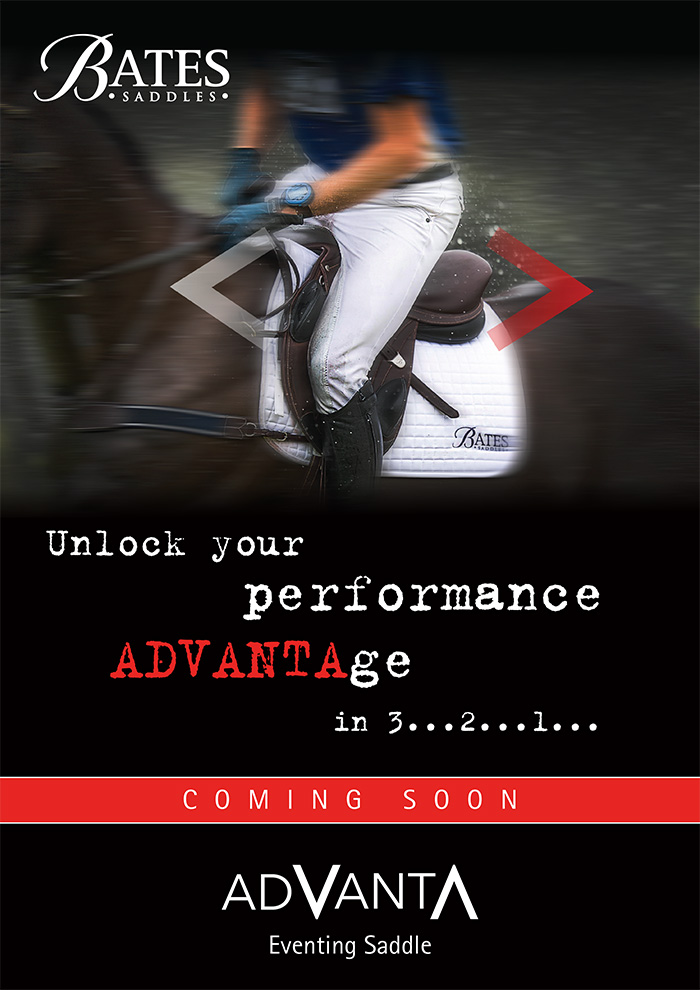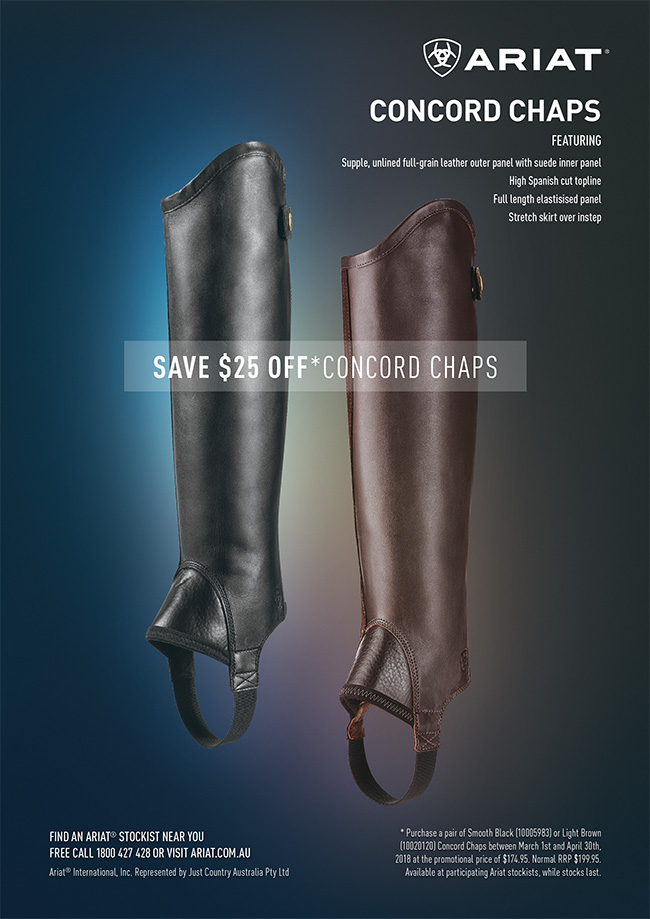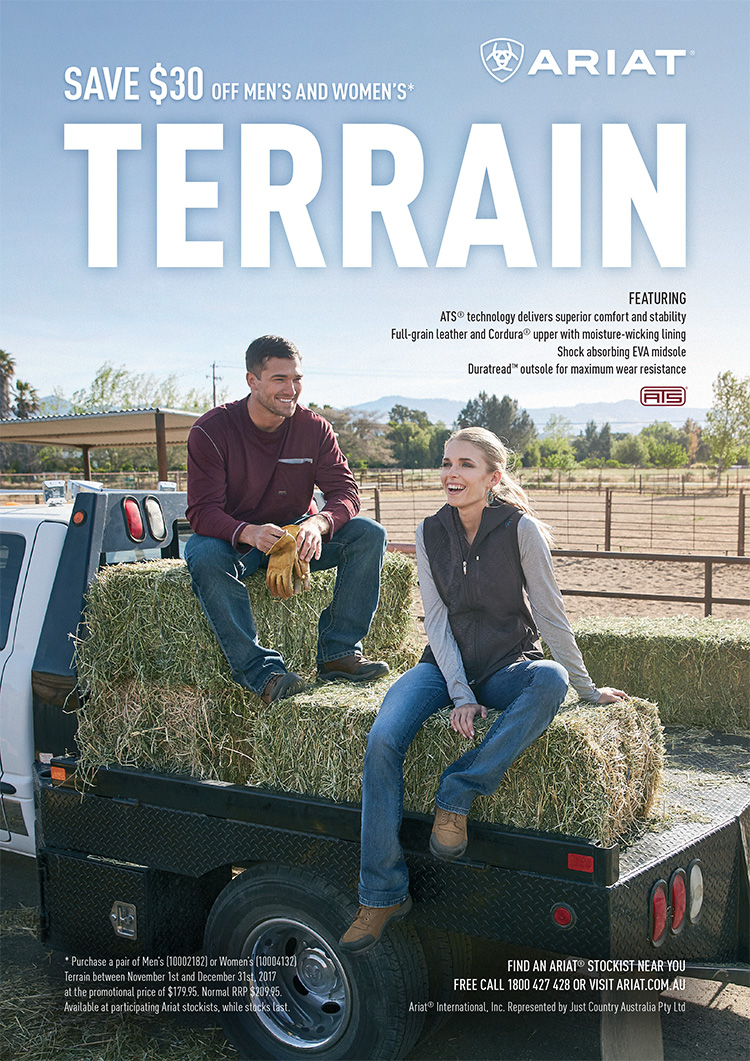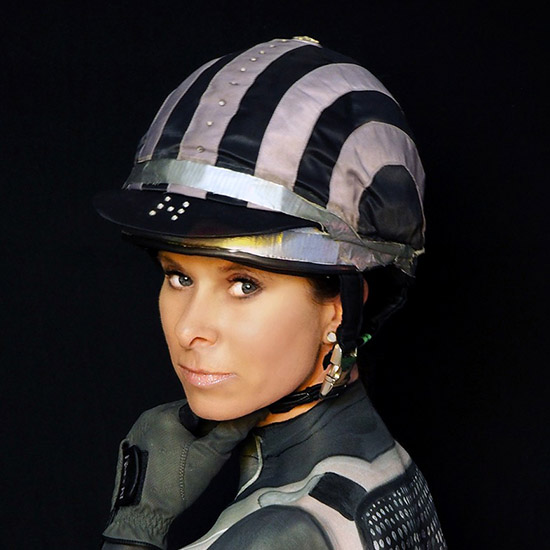
When it comes to eventing, Bettina Hoy has been there, done that, not once but several times. The diminutive lady has competed in three Olympic Games, five WEGs and nine European Championships. She has the honor of being the first German female international eventing representative.
But Bettina shows no signs of slowing down and last year won three CIC*** events – Chatsworth, Houghton and Luhmühlen.
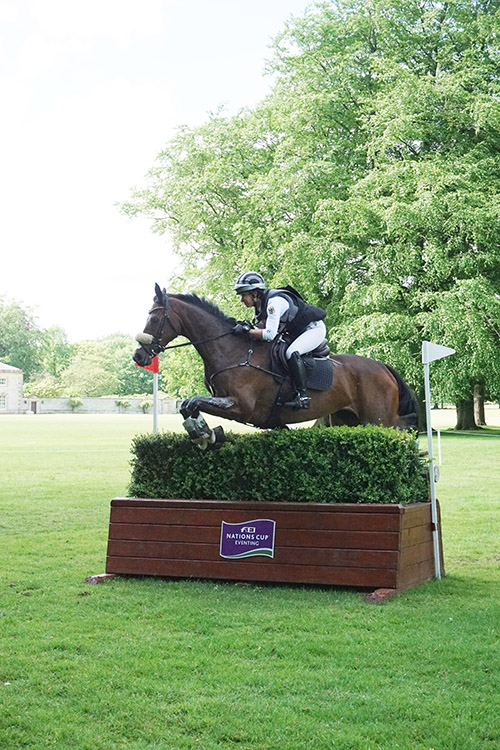
Photo FEI/
Here is Bettina in winning form last year at Houghton Hall, where she and Mr Medicott finished on their dressage score of 35.3 to take out the three star event.
Bettina is very much a product of that well-oiled machine, the German Eventing Team, and based at Warendorf, she has access to some of the world’s leading coaches. Lucky then that she finds time to visit Australia and teach – and encouraging for our future that two top Aussie competitors are smart enough to take time to learn from her.
Sit back and enjoy her insights, it doesn’t matter if your thing is eventing or showjumping or dressage, or you just want to ride better at home, there is so much to learn…
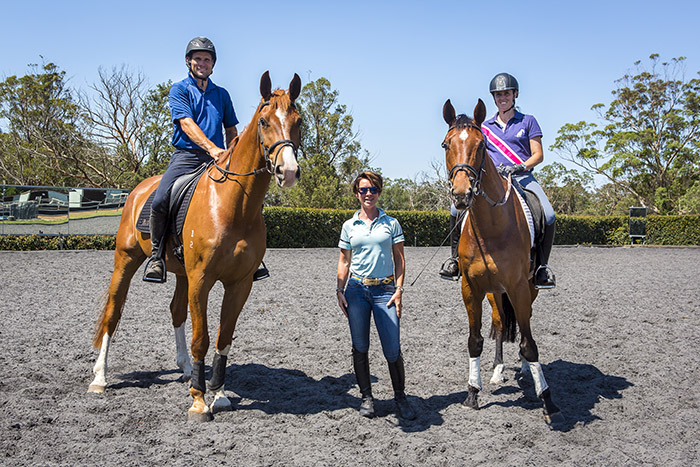
It’s not every day you get to watch Olympians working with Olympians, so it was a privilege and a joy to sit and watch Bettina Hoy give some dressage lessons to Shane Rose and wife Niki.
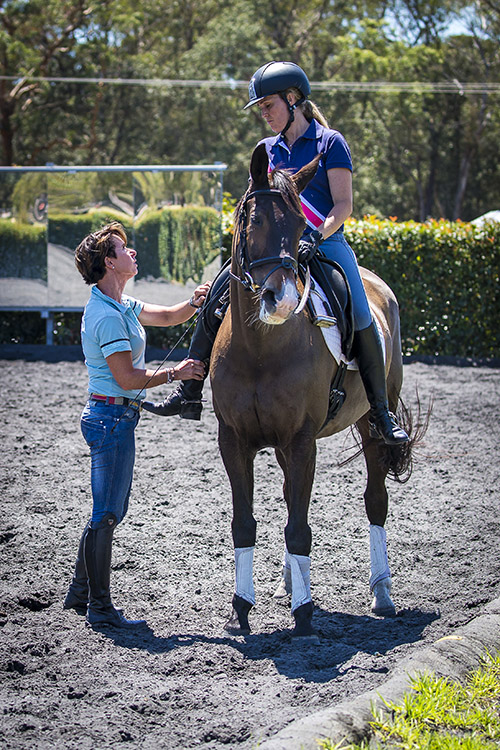
Niki was in the arena with her new acquisition, Dudansa, a De Niro mare that had just arrived in Australia. Nikki kept her in England for a few months after her purchase in Holland. The nine-year-old, who had just started changes, was still settling in after her trip and quarantine.
Bettina wanted the horse to react better right from the start, “Get her short and sharp to the leg. Balance her on the outside first and then flex her. Use your leg before the whip. You have a little more weight on your left seat bone. You need to put more weight into the right stirrup. Push your right hip toward your right knee.”
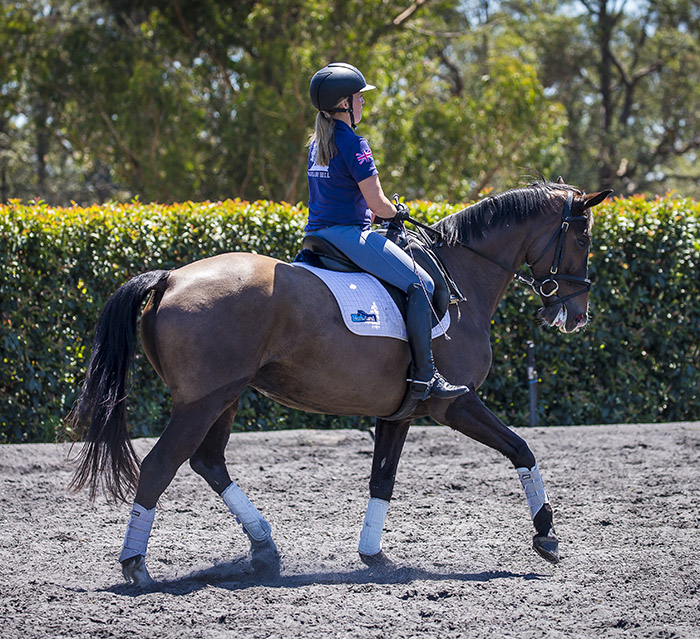
“Forward and back in the trot. Shorter and sharper with the spur. That’s it, play with her back, don’t block her back. One rein at a time. Now shoulder in and do those transitions in a smaller version in the shoulder in. Little bit more outside rein then relax it again.”
From the shoulder in, Niki had to take the mare into leg yield and keep playing between the two exercises trying to get the mare to take her weight off her left shoulder to allow the hind leg to come through. “Energise and let go. You want the energy, but not the speed. Half halt on left rein.”
“Now half pass right. Open your leg from the hip, especially the right,” and then Bettina got serious…..no stirrups! This helped Niki better feel where she was in the saddle before going back to the exercises, moving the mare’s body around, “Then shoulder in, half pass again. Alternate. Make her sit. Then half circle right, shoulder in and half pass right. Keep your right leg on. Yes. Turn the front off the track first when you go into half pass. Bend your knees a little bit. Open your legs from the hip but keep your knees bent. Keep bringing her outside shoulder over toward the inside.”
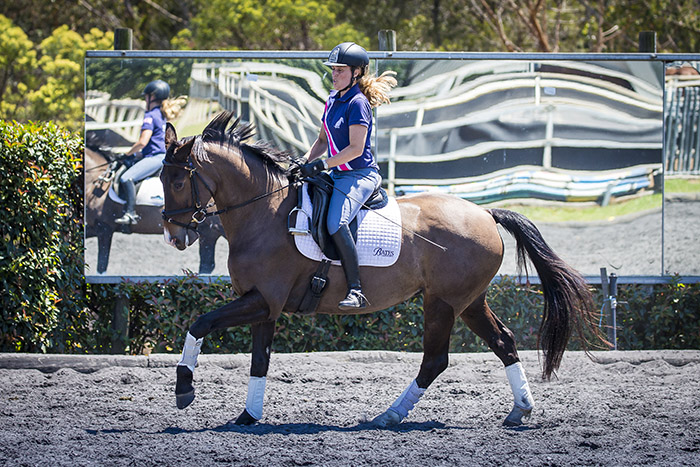
It was then time to canter but Bettina explained how she wanted Niki to not have Dudansa run away from the canter aid but to keep her on her back end for a couple of strides by keeping the leg against the horse’s sides and to maintain straightness by feeling that she had the outside shoulder in front of the quarters. It was important to keep talking to the mare and getting her to re-balance. This was achieved through canter/walk transitions, “Half halt, let go, play her back. She needs to spend a little bit more time on the hind leg in the transition so give a little bit more slower aid. Don’t pull on the inside rein. Apply your diagonal aids; inside leg and outside rein. Flex a little. Don’t push her sideways onto the outside shoulder. That was good. That’s the same feel you want to work towards when you start canter pirouette. You basically do strike offs and turns.”
This prompted the next exercise of travers in canter on a circle, basically a very big, working pirouette with Niki, “playing and letting go”. This was all setting the horse up beautifully for flying changes and Bettina had some advice before Niki gave them a go, “Have her a little bit more forward in front of the leg that’s asking for the change. Your old inside leg works and then that leg goes back in the change. That’s all. Keep sitting up.”
When the first couple of changes didn’t go quite to plan, Bettina had some more advice, “Don’t block on the outside rein because that will be your new inside rein and you will block her and get a late change. You have to ask in two or three stages, not one because just everything at once doesn’t give her brain enough time to react. Keep her a little bit rounder and softer. Do it again. Just really easy. Don’t move the new outside leg back and ask for the change in the one go. Move then new outside leg back first then ask for the change. Sit down. Ja! Perfect. That was a really good change.”
Niki had done her whole lesson without stirrups and now was ‘allowed’ to take them back for the final stretchy trot before finishing.
Next Bettina works with Shane and a new star
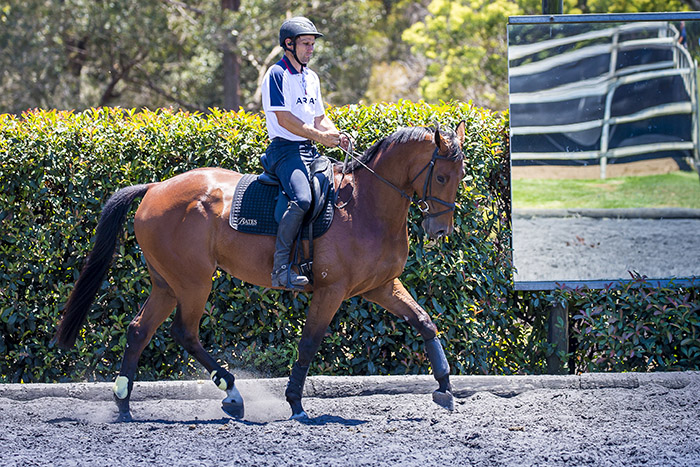
Shane was next in the arena aboard his new star Swiper, who has just gone 3* and was fresh from his win in the CCI 2* at Wallaby Hill. While Shane has worked a lot to improve the horse’s canter, he still has some concerns, “He couldn’t canter a few months ago when I came back. Now he canters around quite nicely. He’s really fast. I actually need to slow him down cross country. He can really gallop. He used to hold his neck quite tight and I had to get his neck softer. I think he’s improved a lot. He does everything, but if he worries about his canter, his changes are the same. He’s a real worrier. He’s not hot as such, just worries a bit.”
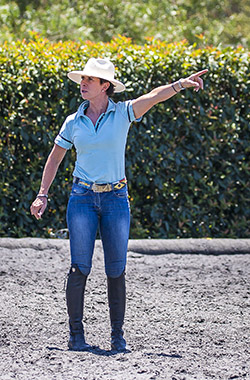
Bettina wanted things really straight forward and simple for the horse, so they started with canter/ trot transitions with the horse remaining straight. “That’s good. But just keep your inside leg on to keep the inside hind leg activated. That’s it. Position the front. Get your heel to the horse a little. You’ll need that for the changes. If the flying change worries him, you want to use that leg that will ask for the change so he gets used to that leg. Do half a walk pirouette to change the rein and canter the other way. And transition to walk. Easy, just give him time. Keep you legs on, but not gripping.”
“Place his shoulders then leave him so you leave that front end open all the time. Now walk and canter again. Think shoulder in into the canter transition. A little bit slower with your movements. And travers in canter. It’s a working exercise; working on the flexion. Pick a line big enough that you feel he can do it.”
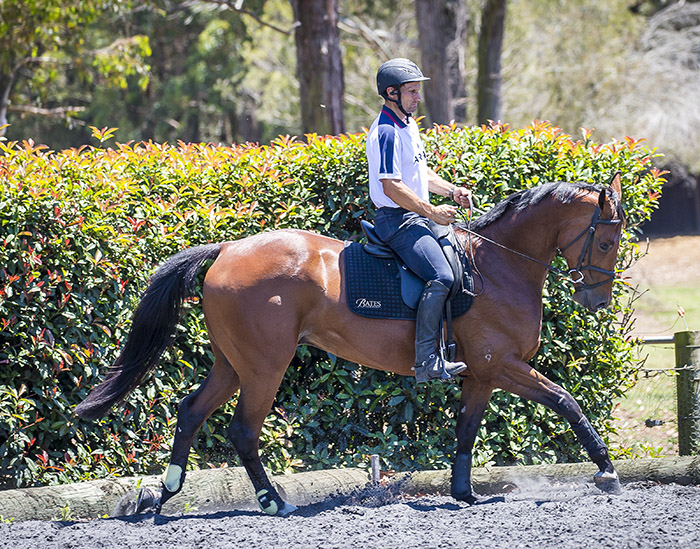
Swiper was now soft and comfortable enough to start looking at the changes and Bettina explained how to go about it. “Changing to the right. Leave the right leg where it is and just take the left leg back. Don’t push his bum right, just move the leg. Just touch one rein at a time. One door always has to be open. That’s it. Can you feel when you position the front end the horse comes more through? When he is aligned he can bring the inside hind leg under better.”
“If you feel him getting too rushed, just bring him to the walk. Good and canter again. Flex him to the outside just to soften him. He can come lower, but it has to be from the wither or else he hollows his back too much. The leg asking for the change is the heel rather than the whole leg so you don’t get an over reaction.”
The work was gentle and all about softening and keeping the horse relaxed. Shane admitted that when the horse ran after the change, perhaps he was blocking him too much. Bettina was focusing on these transitions. Corners could also be used in the same way; to bring the horse back and give it a moment to think and prepare for the next exercise.
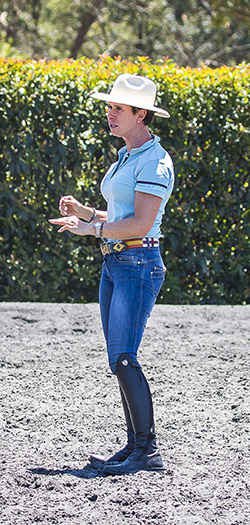
Bettina continued on the transition theme in the trot work, beginning with trot/ walk transitions on the straight line to keep the horse straight and then, fewer strides walk in between and then just thinking walk without actually doing it, “When he comes back, then swing him forward, but just with your posture.”
Next was some shoulder in and half pass work, “Keep him wrapped around your inside leg. Let the nose come forward. Outside rein positions the shoulder. In the half pass, we want him to cross over more. Half halt on the outside rein. Work him to the inside flexion; ride the outside leg into the inside flexion. Then forward a few steps in between to refresh.”
The half pass was then ridden in canter before returning to look at the changes on a serpentine. “Half halt then let go again. Good. Then a few walk/ canter transitions to remind the horse to listen, then canter half pass, stay in counter canter then start serpentine in counter canter and flying change on the second loop.”
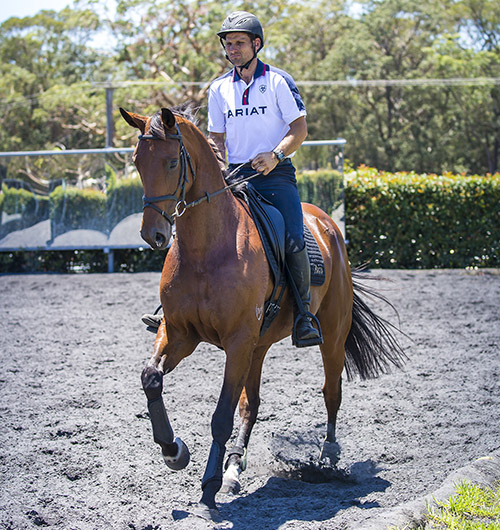
Shane said that the horse felt like he was going to run off after the change: “Just ask with your posture and wait a bit, put the aid on and just wait.” Shane tried again, continuously talking and calming his hot little bay, “Steady, mate. Whoa, mate.” Swiper came to the party and offered some lovely changes, a good place to finish the session.
Bettina explained, “He has a neck like my horse Designer. Sebastian Heinze (German under 25 dressage coach) has helped me with him and he says you just have to drop from the wither. Then when he is loose you can bring him up and he will keep the neck soft and the nose out. Then you can sit on him easier.”
next comes Shane’s WEG prospect, Virgil
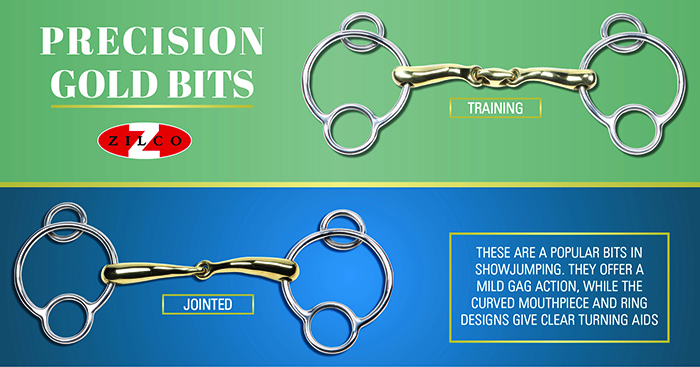
Australia, click here to find your nearest stockist https://goo.gl/tgok94
New Zealand, click here to find your nearest stockist https://goo.gl/fhfojk
United Kingdom, click here to find your nearest stockist https://goo.gl/Aufeui
Europe, click here to find your nearest stockist https://goo.gl/Zv44DD
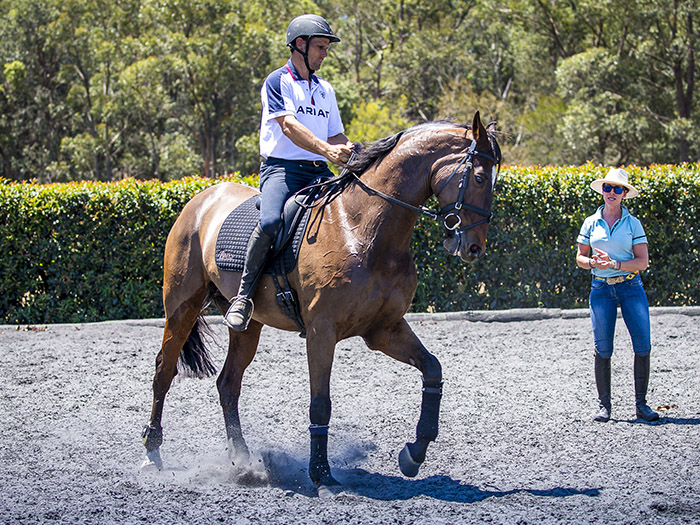
Next up was Shane’s WEG hopeful, Virgil. Shane wanted to work on getting more relaxation: “He used to hold his breath a lot. He doesn’t go to a competition and get tense, he just holds. If I tried to get more in the half pass, he’d just hold more, so now I just wait until he gives to it.”
“So in canter, when he comes back, I try to keep it active. But when he goes out, he’ll get tight and kick up rather than do the change. So, I’ve been taking the flexion until he isn’t tight and getting him to relax. It’s all about, if I can get him to canter and active and soft, then it’s good.”
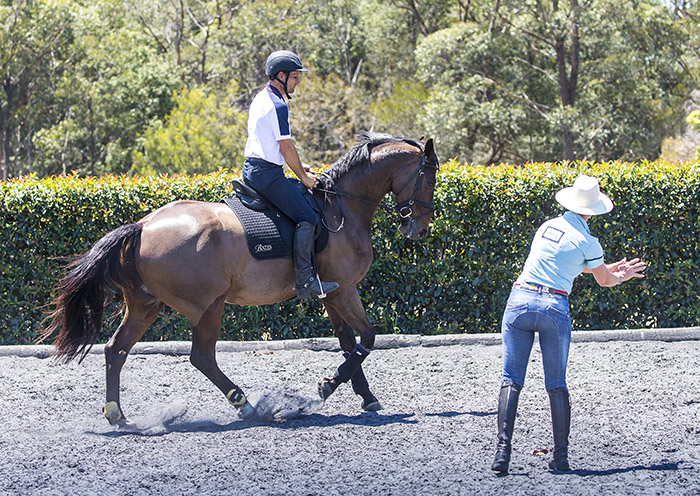
Bettina started with getting Shane’s aids sharper and quicker, and keeping things quieter in between, so the horse remained attentive. “Drop your hands a little bit then move him out. That position will also keep you broader in your back. Keep the contact quieter so he starts stretching into it a bit more. Flex him by taking your hand out to the side rather than over. He needs to drop more from the wither without your hand coming back, so he can work more over his back. Quicker with your spur aids. Leave him down there for the shoulder in to take control of the front end, without pulling, then quicken the backend while he’s in that position.”
“Strike off into canter. Kick him a bit off the floor; short and sharp. Keep him straight with the outside rein. Just use one rein at a time or else you’ll shut the engine down. Leave him down there and long. Have enough connection in your hand but not shorter. Quiet and slow with the inside hand. Leave the hands close to the wither.”
Then back to trot, “Use the outside rein for the downward transition so he doesn’t fall onto the outside shoulder. Get him to sit a few more strides before the downward transition. Just wait a little bit longer for it and keep him sharp to your spur. Hold the canter small, come back to the outside rein, make him sit, wait, yeah, that’s it. Wait in the trot until he’s more secure before you ask him to go forward again. This helps to make it all more expressive. Let it come more from your posture. Slow the front end and activate the back end. Take the speed out but keep him active. Good. You need to get him to sit just that little bit longer on the inside hind leg. This will also get the changes better.”
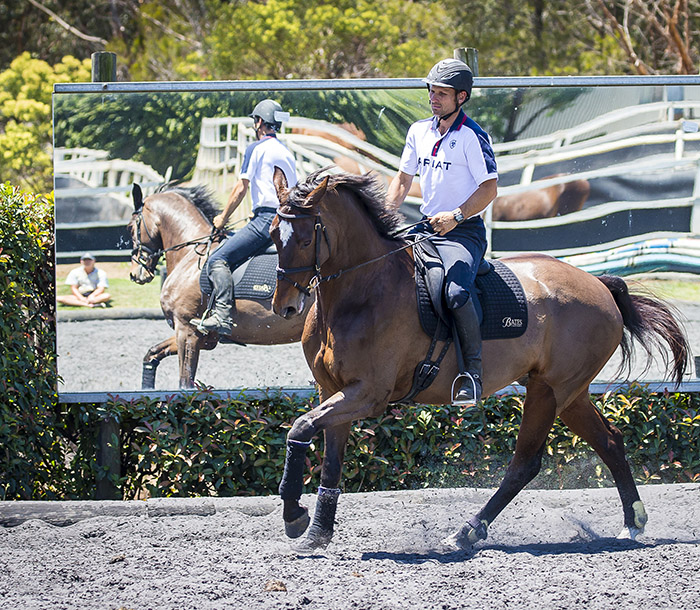
After a break it was time for changes. The first change was clean but a little flat, so back to the earlier softening exercise, “Keep the front end soft from the wither and keep the back end active. Sit up. Outside leg a little bit further back. That’s it.”
The changes still a little finessing, “You’re pushing the change sideways to get it clean, but you need to swing your inside hip forward to get it straight, not sideways. Play with the flexion to keep him soft, keep a soft hand and elbow, stay soft in the hand and work the hip forward. As soon as you feel him tighten, you need to drop your hand and get him to drop from the wither again. If he’s too high, he can’t get a good change.”
Working the canter on a 10 metre circle, Shane could get Virgil well bent around the inside leg therefore allowing Shane’s hip to work forward easier. “Now ride forward through the change, and not as if you’re going to turn afterwards, ride straight forward and only move the leg that’s going to ask for the change (old inside leg/ new outside leg). People try to move both legs for the change but then you lose your support and they jump sideways.”
A little check in with some walk/ trot transitions made sure the horse was through and connected, “Build that connection first before the transition. Then just push from behind into that outline. Keep the outside rein, just feel your outside ring finger and trot him into it.”
This connection helped prepare the horse for shoulder in and half pass, because positioning and maintaining the horse’s bend and angle in those exercises relies on a good connection from the back end forward. “In the half pass, look where you’re going and you get there better. It’s like what we do cross country. Early sight. Look where you’re going, not down. Keep playing away. Better. Allow the flexion and only position the shoulder.”
Canter half passes were in order once the trot work was smooth, “Collect the canter a little bit more on the outside rein. Collect him into the flexion, one rein at a time, before you half pass. Down your hands, not so high. Keep dropping him from the wither. Then think more and smaller canter strides. Ja!”
And then back to the changes. The change was clean, but Virgil still had that urge to run afterwards. So Bettina wanted Shane to do the changes in stages, changing his legs first and then asking for the change so as not to ask too fast and unsettle the horse. She also changed the line from across the short diagonal to down the long side so Virgil didn’t anticipate. “Stay relaxed about it. All you’ve got to do is unlock him. Just keep unlocking him and give him more time to think about it.” And it worked a treat. Virgil was really starting to ease into the whole idea.
next Niki on a young Thoroughbred
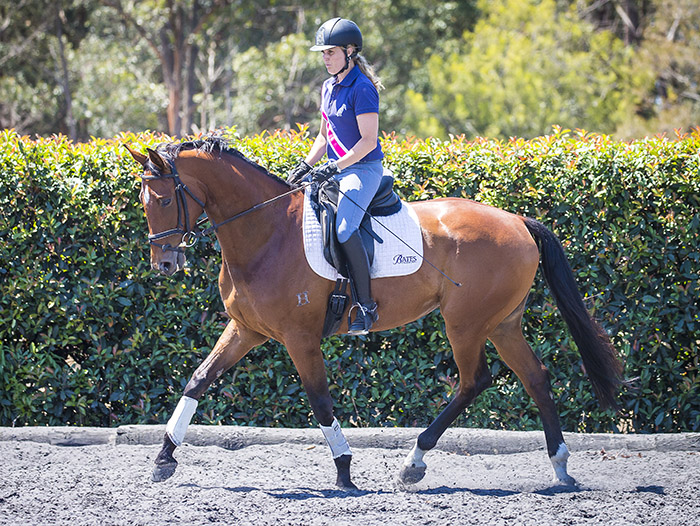
Niki was back on a her five-year-old Thoroughbred, Dreamcatcher. He’s the current Australian Champion at 95cm. Niki won two Australian Championship titles the same day she and Shane flew out to compete at Badminton! That’s dedication!
Niki wanted to improve the horse’s contact and Bettina suggested using an eggbutt rather than a loose ring snaffle and perhaps trying a Micklem bridle which has given her success in the past.
“I start with the young ones with shoulder fore on a circle line to help them get more range, which will help the shoulder in down the track.”
“Start thinking of flexion rather than sideways. Then apply your diagonal aids, inside leg and outside rein into that flexion. Keep the flexion consistent. Loosen those muscles up. Keep your inside rein closer to your hip rather than take it high and over the neck. Then you can work him into that, and then he can go more away from your inside leg. Good. Now quicken the hind leg.”
“And the other way. Balance him first on the outside rein. Communicate with him quietly and address his balance and then look at the flexion. You need to work him into the correct outline rather than hold him there. Your inside leg needs to talk to his inside hind leg so it steps under the point of gravity. Don’t let him fall onto the outside shoulder. That’s it. Keep him in front of your leg. Great. You positioned his shoulder then you pushed the hind legs up, and it became more expressive. The upward position that you need later for dressage comes from an active hind leg. If you fiddle them up with your hand you ride them away from the contact. Take your hands wider. Keep your hands at hip width. Your hips theoretically need to fit through. And then you push the hind legs up. The up comes from an active hind leg when they’re ready for it.”
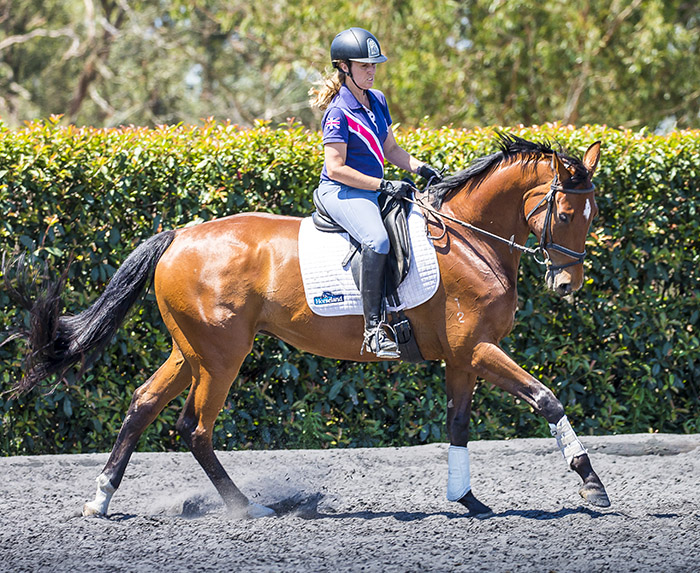
Then into the canter, “Put your leg on and keep it for the next 4-5 strides. Push into it more with your leg. Push him out into those canter strides. If he sucks behind your leg, he won’t find the next gear. Push him out of that comfort zone. Then keep that push as you balance him with your outside rein. Your hands are good now. Keep the same push, but balance him with the outside rein. Legs are there for the energy and engagement and the seat is there for the length of stride. Can you feel the paces get bigger now?”
Bettina then gave the pair an exercise at the walk; a few strides at a time of leg yield on the circle. “All he has to do at this stage is to go away from your leg so he starts crossing a little bit longer and is realising his range. It’s a bit of an obedience exercise as well. Keep the hands low so the back gets stronger so that it can support the higher position later on. A lot of people try and get it artificially from the hands and then the horse hollows the back and then if the back is hollow the horse can’t step under from behind. Wait until the back is strong through these exercises.”
Then Niki was to go straight from this exercise into the trot to get Dreamcatcher to sit a bit more. Shoulder fore down the long side in sitting trot and rising on each short side to break it up a bit and to refresh the energy without adding speed. The canter was revisited and the change in the horse from the exercises could be seen:
“Now he’s pushing a bit more off the floor. A little bit shorter with the reins and make sure he doesn’t push out onto the outside shoulder. Keep your diagonal aids. Softer inside rein. Try and keep your elbows in front of your ribcage. If you hang too long in the inside rein you shut the engine down, so consciously let him go every now and then on the inside. Good. Back to trot. Slow him down with the outside rein but keep your inside leg on. You want the energy, but not the speed, because the speed causes the front end to run away from the back end, and he can’t stay connected. That’s a better rhythm for him because now he can swing.”
“Don’t change what you’re doing, just wait until he understands. Now he’s really lifting his back.”
Bettina talks about teaching next
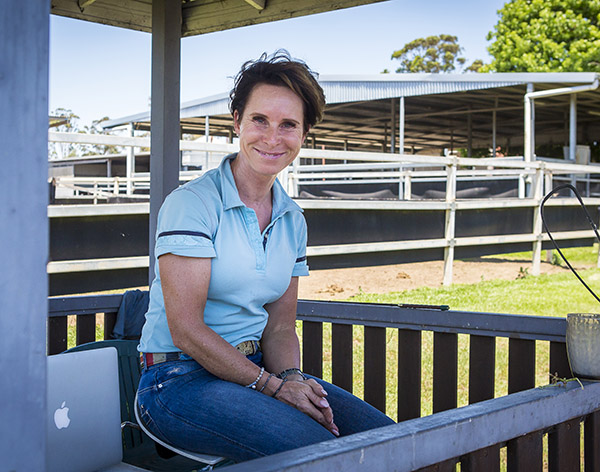
Bettina on teaching Shane and Niki:
“When I’m here, I have a lot of low level riders that I’m training which is great. It’s great that they want to come to me for advice. However it’s really rewarding working with riders like Shane and Niki, when you say something, they actually know exactly what you mean and they can put it into place straight away. That’s very rewarding for me because you can see a result straight away. This is the level I ride at, and I really want to see them getting really good marks. I never, ever see it as competition to me because if their dressage score gets better, then it’s a little win for me. I almost bask in their glory as a trainer, which is cool. I love the fact that if I try to explain what I do and why I do it, that it has an effect, and it works for someone else.”
And a word from Shane:
“That’s actually one of the things that’s good about Bettina is that she’s currently riding. When she’s telling you something, it’s first hand. If it’s not working, she can get on and say, ah, this is why it’s not working. Sometimes it might look right, but when you get on it can feel different because you’re not doing this or that. She’s currently not only competing but she’s actively riding and training.”
Bettina agreed, “And that’s how I pick my trainers as well. Working with Sebastian Heinze or Klaus Balkenhol, I would always say, well you have a sit. You show me. Then hopefully when I get back on I can feel the difference.”
Huge thanks must go to Shane, Niki and Bettina for allowing me, my computer and camera arena side. Without their generosity we wouldn’t have this opportunity.


